Most travellers don’t hear about Colca Canyon until they arrive in Peru. This spectacular natural feature is in fact one of the deepest canyons in the world. Lined with cactuses and watched over by soaring condors, the landscape is straight out of a western movie.
In this ultimate guide, I will give you some interesting info on one of Peru’s lesser-known attractions. You will also find all the details you need before booking a tour or trekking in the Colca Canyon.
Looking for a short trek? Here are my 5 favourite tours to Colca Canyon:
- Colca Canyon 2-Day Tour (incl. transfers between Arequipa and Puno)
- Arequipa-Colca Tour (incl. Cross of the Condor viewpoint)
- Full-Day Colca Canyon Tour (incl. transfers to and from Arequipa)
- 2-Day Colca-Puno Trek (incl. option of return to Arequipa)
- Colca Canyon Full-Day Guided Tour (incl. Arequipa transfers and condor sightings)
See more short Colca Canyon trips and tours.
Colca Canyon Peru
Where Is Colca Canyon?
Colca Canyon lies about 160km / 100miles northwest of Arequipa in the south of Peru. You can fly to Arequipa from Lima or Cusco with buses running daily between these main cities.
You can book tours, arrange transport and prepare for your trek from Arequipa. There is a lot to see around Peru’s White City. Consider spending a few days in Arequipa before or after you visit Colca Canyon.
From Arequipa, it is a 4–6-hour drive (210km / 130 miles) to get to Cabanaconde, a small town right on the edge of the Colca Canyon. The drive takes you past Chachani and El Misti Volcano. You will also cross the vast plains of Salinas and Aguada Blanca National Park.
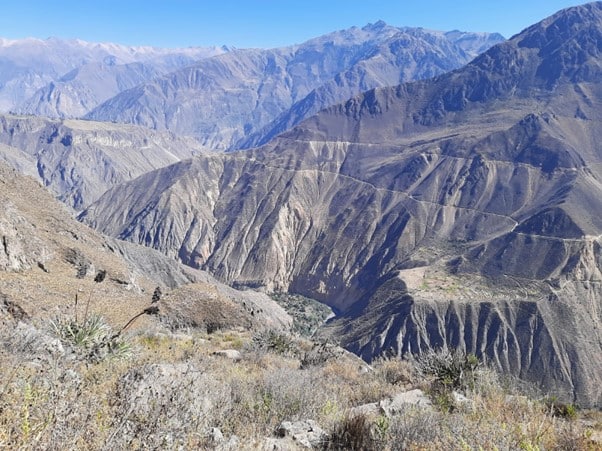
Colca Canyon Facts
Before planning a trip to Colca Canyon, it's a good idea to do some research on the area. Below are four interesting (and surprising) facts you might not have known before about one of Peru's largest and most fascinating natural wonders.
Colca Canyon is twice as deep as the Grand Canyon.
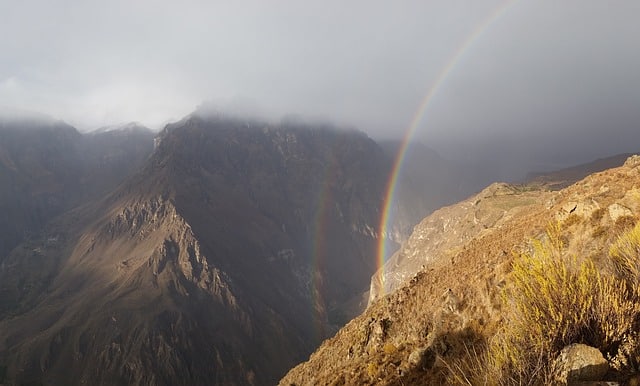
Colca Canyon is amongst the 5 deepest canyons in the world. It is approximately 3,400m (over 11,000ft) at its deepest point.
This is almost twice as deep as the famous Grand Canyon (1,829m / 6,000ft). If you hike down Colca Canyon, you will descend around 1,200 vertical meters (3,937 feet) into the valley.
A little-known fact is that Peru’s deepest canyon is actually Catahuasi Canyon. This lies just over 200km / 124 miles away from the Colca Canyon. Catahuasi Canyon is 3,535m / 11,600ft deep. Not many people trek Catahuasi though as this area is more difficult to access than Colca Canyon.
Colca Canyon is one of the best places to see Condors.
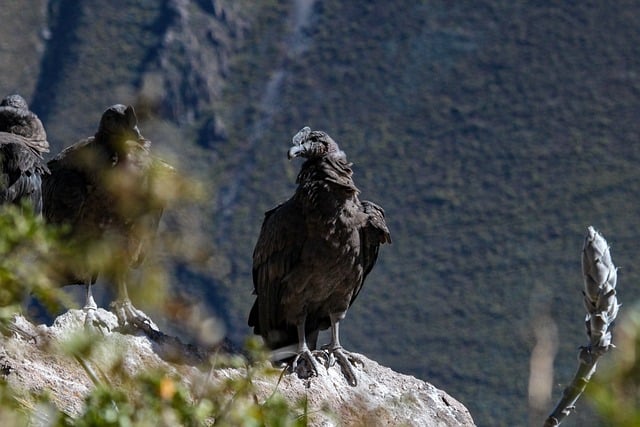
Many people visit the Colca Canyon exclusively for a chance to see condors. The Andean Condor’s wingspan can reach up to 3m / 10ft. There's a good chance of seeing these majestic vultures soaring on thermals high above the canyon.
The best time to see Condors is in the morning. If you can, spend a night in the town of Chivay. The Cruz del Condor viewpoint is roughly 40km / 25 miles from this small town. If you stay overnight, you will have time to stop and look for Condors on the way to the Canyon.
There are people living in the Colca Canyon.
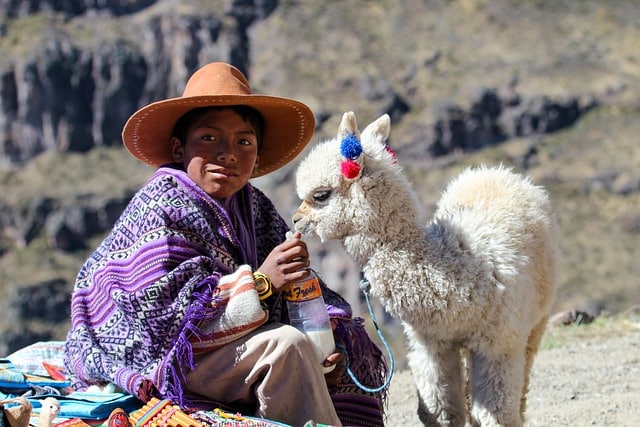
Indigenous communities have been living in the Colca Canyon for generations. The way of life here hasn't changed much since the days of the Spanish Conquistadors.
The Canyon residents are mostly farmers and craftsmen. They produce some excellent alpaca wool and embroidery crafts. Each community has slight differences in language. They can also be told apart by the shape of the hats they wear and the colors and patterns of their outfits.
There are hot springs near Colca Canyon.
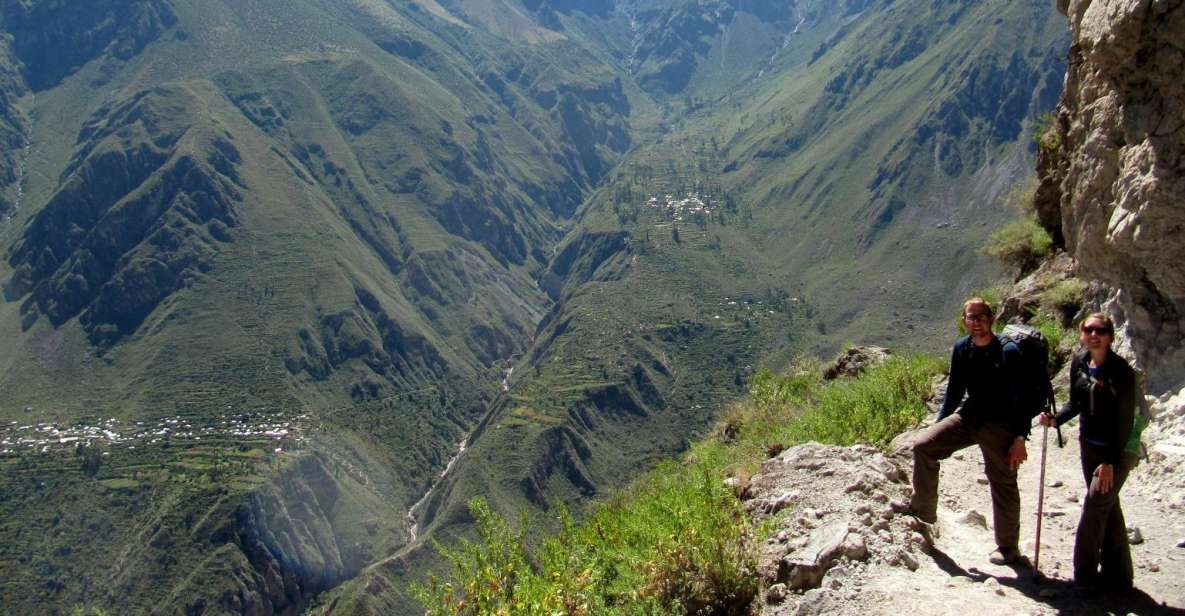
With so many volcanoes around, it’s no surprise that you can find thermal waters. The La Calera baths are public hot springs only 3km / 1.8 miles away from Chivay. There are also natural hot springs near the small town of Yanque.
It's a good idea to spend a night in Chivay or Yanque after your trek to Colca Canyon. Both towns are a few kilometers from the trailhead. Use the opportunity to soak your aching muscles in these relaxing waters.
Where to stay? Here are 5 of my favourite accommodation options in Arequipa:
- La Hostería Boutique Hotel
- Wyndham Costa del Sol Arequipa
- Sonesta Hotel Arequipa
- Casona Plaza Hotel Arequipa
- Casa Andina Premium Arequipa
See more Arequipa accommodation options.
Colca Canyon Tours vs Colca Canyon Treks
It's important to know that the tours to Colca Canyon are different from treks. Most of the tours are focused on sightseeing around Colca Canyon. Very little hiking is involved in these excursions.
Be very sure you know and are happy with the itinerary before you book a tour. Later in this article, I will look at treks and trekking tours in Colca Canyon.
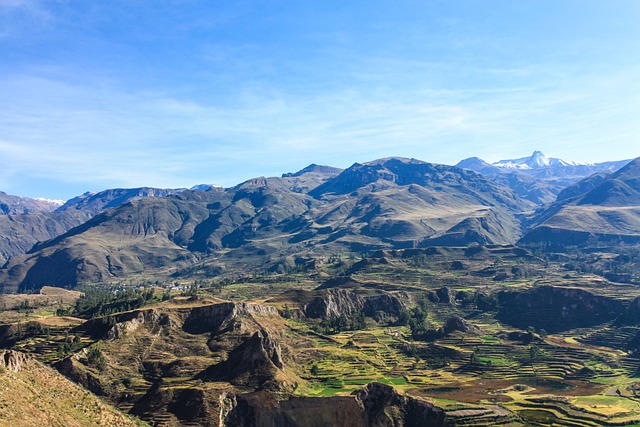
Colca Canyon 1-Day Tour Itinerary
Tours depart from Arequipa around 3am in the morning (No, that’s not a typo!). From there, you will then drive to Chivay where you will stop for breakfast.
After eating, you will continue to the lookout point. Here, you will spend about 40 minutes spotting Condors and admiring views of the canyon.
Next, most Colca Canyon tours go to Chivay Hot springs. You will need to pay an extra 15 soles for entrance. You will spend an hour at the hot springs before getting on the bus back to Arequipa.
On the way back, you will make a 15-minute stop at Salinas y Aguada Blanca National Reserve. Hopefully, you will see some wild alpacas, llamas, and Vicunas during your visit.
Colca Canyon 2D/1N Tour Itinerary
Day 1
A two-day Colca Canyon tour gets going a little later (around 8am). You will stop in Salinas y Aguada Blanca National Reserve with a volcano viewpoint on your way to Chivay.
Groups spend the night in Chivay. When you arrive here, it will be time for lunch. Enjoy some free time in the afternoon with the option of a short hike into the Canyon. In the evening, you can visit the hot springs.
Please Note: The entrance fee of 15 soles is not included in the tour price.
Day 2
After breakfast, you will be driven to Cruz del Condor viewpoint. You will spend about 40 minutes here, then go to one or two other points of interest in the area. Most companies visit Atahuilque (a viewpoint and Incan site) and Maca (a traditional town and craft market).
Afterwards, you will return to Chivay for lunch. This final meal is not included in most tour prices.
After lunch, you will make the long trip back to Arequipa.
Please Note: There are options for booking 2-day tours that continue on to Puno. This is a good option if you plan to visit Lake Titicaca or the world-famous floating islands of Uros. These packages can also be customized. You can add or exclude meals, special tours of the Lake Titicaca ruins, accommodation in Lake Titicaca, and entrance fees. It works out cheaper to arrange these things yourself.
Looking for a short trek? Here are my 5 favourite tours to Colca Canyon:
- Colca Canyon 2-Day Tour (incl. transfers between Arequipa and Puno)
- Arequipa-Colca Tour (incl. Cross of the Condor viewpoint)
- Full-Day Colca Canyon Tour (incl. transfers to and from Arequipa)
- 2-Day Colca-Puno Trek (incl. option of return to Arequipa)
- Colca Canyon Full-Day Guided Tour (incl. Arequipa transfers and condor sightings)
See more short Colca Canyon trips and tours.
How Much Does A Colca Canyon Tour Cost?
Online prices start from $50 for a full-day Colca Canyon tour. A two-day tour costs about $80. It's almost half the price if you book your tour directly in Arequipa ($40 / 160 soles).
Tour prices include accommodation, a guide, and most meals. You will still need to pay 70 soles for the entrance fee to the Canyon though.
Is It Worth Doing A Tour To Colca Canyon?
If you book a Colca Canyon tour, it's much better to take the 2-day option. The 1-day tour is a long day and you will spend almost all day on a bus. The two-day tour is more relaxed. There is also not much difference in price between 1 and 2-day Colca Canyon tours.
I chose not to do a guided tour as I’m not a huge fan of packaged experiences. Also, others said they spent more time in rural towns than at the Canyon itself. Tours have a big cultural focus, so expect to watch traditional dances and shop for souvenirs.
If you want a more authentic experience, I’d recommend getting to the Canyon on your own and spending a night in Chivay or Yunque. Adventure enthusiasts should focus more on trekking in the Canyon than the more popular tourist attractions in the area.
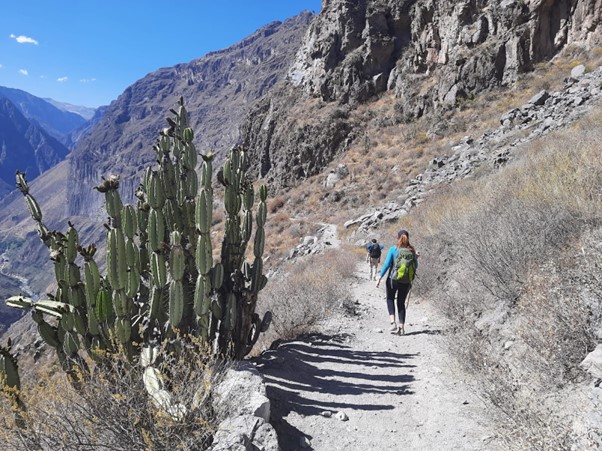
Trekking In Colca Canyon - What You Need To Know
Where Does The Colca Canyon Trail Start?
The small town of Cabanaconde is the starting point for Colca Canyon hiking routes. There are three main trails leading from Cabanaconde. Which route you take depends on your fitness and whether you have two or three days available for your specific trek.
How Difficult Is The Colca Canyon Trek?
Hiking the Colca Canyon is fairly challenging. It is a canyon, so you will be going down and back up the steep slopes. However, as you can choose your route, you get to decide how much to take on.
The final day is the most difficult part of the Colca Canyon trek because you will need to hike up to the rim. There are going to be some moments of frustration when you think you are at the top, only to find a false summit.
Compared to The Salkantay Trek or Classic 4-day Inca Trail, this hike is much shorter. Colca Canyon is at an altitude of 3,400m / 11,155 ft (similar to Cusco). You will need to be acclimatized to this elevation by the time you arrive.
See more in our article on preventing altitude sickness.
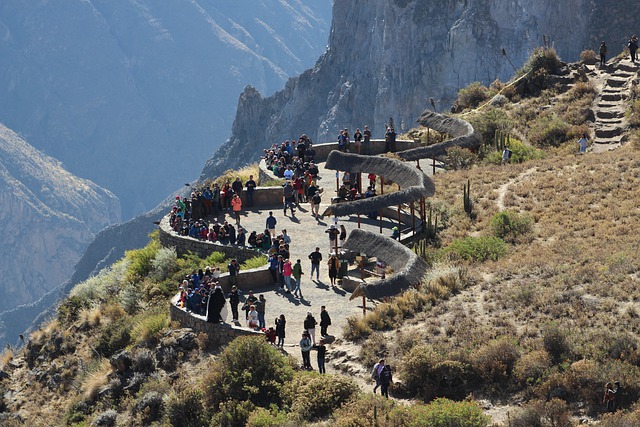
Different Routes of Colca Canyon
There are multiple different trails to Colca Canyon varying in distance and difficulty. There are also variations of popular trails. Plus, most routes can be done in reverse. Below are the most popular ways to hike the famous Peruvian canyon.
Cabanaconde - San Juan De Chucchu - Sangalle (overnight) - Cabanaconde Trail
This is the most popular route and is around 20km / 12.5 miles. This is also the route that 2 and 3-day trekking tours usually follow (see more on this below).
8KM / 5 Mile Trail
This is the shortest and easiest route by far. This route takes a more direct trail down to Sangalle oasis on the first day with a 2-3 hour descent. After spending the night in Sangalle, you have a 5-6 hour trek zig-zagging back to the top of the canyon.
Western Loop Trail
This is a 25km / 15 mile loop and a popular choice for experienced trekkers hiking without a tour. This trail takes you from Cabanaconde, Llahuar, Sangalle, and then back to Cabanaconde. Spend a night in Llahuar or add a second night in Sangalle.
Cabanaconde - San Juan De Chucchu (night 1) - Llahuar(night 2) - Cabanaconde Trail
This is the toughest of all the Colca Canyon routes with a total hiking distance of 28km / 17miles. Don’t take this route unless you are physically and mentally prepared for 6-8 hours and 10km / 6.2 mile of hiking upslope on the final day. It's best to get started before sunrise.
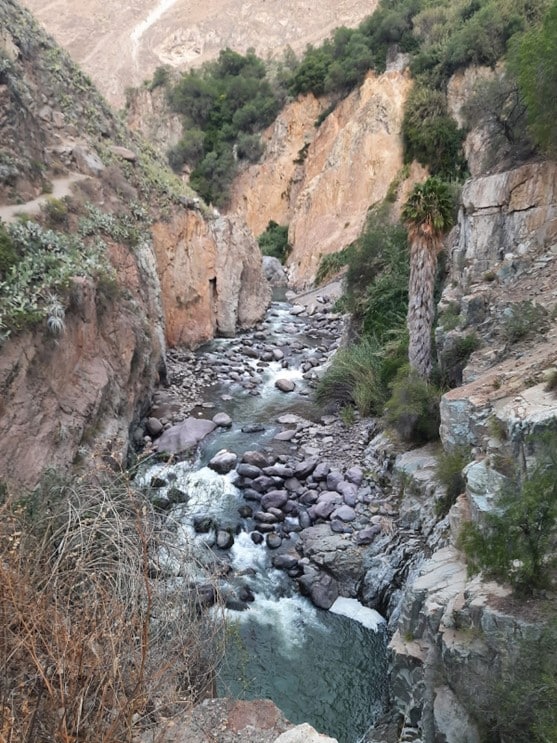
Colca Canyon Trekking Tours
Some Companies in Arequipa offer the Colca Canyon Trek. This is very different to the Colca Canyon tours which I described earlier in this article.
Colca Canyon group treks will take you hiking into the canyon itself. Meals and accommodation are included in the price. If you want to hike Colca Canyon but prefer organized tours, this is a good choice.
Most 2-day and 3-day trekking tours follow the same route. The only difference on the 3-day tour is that you spend an extra night in the valley. You will camp at the lunch stop, which is the same location from the 2-day trek.
Below, you will find the typical itinerary for a 2-day Colca Canyon trekking tour.
Day 1
It’s pretty much all downhill as you descend into the Canyon. This is tough on your knees and temperatures can be uncomfortably hot. It takes around 5-6 hours to reach the river.
After lunch, you will continue for a few more hours on relatively flat terrain. You will stay over at a camp in the valley. There are beautiful pools to cool off in.
Day 2
Trekkers typically rise early for a challenging, 3-hour trek before stopping for breakfast on the trail. Prepare yourself for a difficult morning, with around 1,000m / 3,281 ft of straight walking upslope. You will finish trekking before it gets too hot.
Total distance: 20km / 12.5 miles
Please Note: Some hikers actually find going back up easier than coming down. It depends on your knees. An early start in the cool, dark morning is essential.
Getting To Colca Canyon on Your Own
It is fairly straightforward to reach Colca Canyon by public transport. You have a few options for getting there.
Option 1: By Collectivo
Public minibuses (called collectivos) depart regularly to Colca Canyon. You will need to first catch a collectivo to Chivay though. Get off in Chivay and find another collectivo going to Cabanaconde. This is slightly more expensive than the bus, but the journey is a few hours quicker.
The collectivo stations are on Av. Andres Avelinoi Caceres. This is about 15 minutes by taxi from Arequipa's historic centre. You can ask the reception desk at your accommodation to organise a taxi for an early morning departure. Uber and InDriver (which is cheaper) also work in Arequipa. The taxi should cost around 10 soles.
From here, you can find a collectivo going to Chivay. You will pay around 20 soles for a 3.5-hour ride. You can pay when you board or when you get off. Keep in mind that collectivos only depart when they are full. You may want to walk around between the collectivo companies to find one that is leaving shortly to avoid a potentially long wait.
From Chivay, you will need to get another collectivo to Cabanaconde. Once you get off the first collectivo and walk out the station, you should easily find the next minibus. The drivers know this is a popular connection and time their trips accordingly. This costs about 10 soles per person.
Option 2: By Bus
The second option is to take a bus from Arequipa’s Terminal Terrestre. Buses are slow but a little cheaper than the collectivos.
Previously, at least four companies ran this route. However, since Covid-19, buses heading to Colca Canyon are less frequent. During my time in Arequipa, only Transportes Andelucia was going to Cabanaconde. If you have an update on this situation, please drop us a comment at the end of this article.
I recommend you visit the station beforehand to confirm bus schedules. You can also try calling Transportes Andelucia directly. Alternatively, catch one of the regular buses to Chivay. From here, you can catch a collectivo. Bus tickets generally cost about 20 soles / $6.
Please Note: If you somehow miss the bus from Arequipa, don’t worry. The collectivo stations are a short walk away, so you can still make it to Colca Canyon in plenty of time.
Option 3: By Tourist Shuttle
You can pay to take the tourist shuttle between Arequipa and Colca Canyon. The shuttle will pick you up at 3am and you will stop for breakfast at Chivay, reaching Cabanaconde by 10am. The shuttle costs around $20 for a one way ticket.
Where to stay? Here are 5 of my favourite accommodation options in Arequipa:
- La Hostería Boutique Hotel
- Wyndham Costa del Sol Arequipa
- Sonesta Hotel Arequipa
- Casona Plaza Hotel Arequipa
- Casa Andina Premium Arequipa
See more Arequipa accommodation options.
Best Time To Visit Colca Canyon
The Colca Canyon experiences a very clear dry and wet season. For sightseeing tours, it doesn’t make much difference when you visit. However, if you plan on trekking, take seasonal differences into account.
The dry season is from May-October. During this time, the days can get exceptionally hot. Usually, it doesn’t rain during these months either. The downside to the fair weather is that there will be more hikers on the trail. It is winter in Peru during this time, so the nights get very cold, especially if you plan on camping.
The wet season is from November-April. Most of the heavy rains fall between December and February. You can trek at this time, but you need to be well prepared for the elements.
The trail is steep in parts and slippery when wet. You will need good hiking shoes and weatherproof gear. That said, you can also luck out and end up with dry, warm days during the wet season.

Thank you so much, Alison. I'm preparing for a trek so this info is very useful